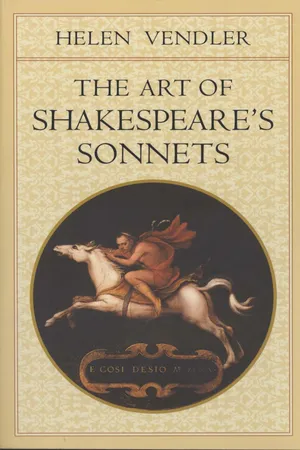
- English
- ePUB (mobile friendly)
- Available on iOS & Android
The Art of Shakespeare’s Sonnets
About this book
"A great achievement, the work of an author with an almost devout passion for good poems."
—Frank Kermode, New Republic
"Criticism of the Sonnets, and by extension, critical accounts of poetry, will never be the same again."
—Tom Paulin, London Review of Books
The definitive guide to Shakespeare's Sonnets from the most accomplished critic of our time.
More than four centuries after its initial publication, William Shakespeare's Sonnets is still very much a living text. Despite all the regalia of its Elizabethan English, despite its baroque grammatical dislocations, Shakespeare's major work of lyric poetry remains an inexhaustible source of literary wonder.
In detailed commentaries on each of the 154 sonnets, Helen Vendler offers a lucid analysis of the verse stylings that we have come to call "Shakespearean." The supreme accomplishment of these fourteen-line poems, Vendler demonstrates, lies not in their often-conventional themes and images—love and death, roses and thorns, summer's heat and winter's cold—nor in some hidden, deeper meaning, but in the seemingly effortless virtuosity of their arrangements. Shakespeare's sly subversions, his boundless capacity for formal invention, and his uncanny ability to breathe life into even the most commonplace metaphors betray a poetic imagination that has never yet found its equal.
Presented alongside both the original and the modernized texts, Vendler's commentaries not only illuminate the sheer abundance of Shakespeare's rhetorical strategies and his dynamic use of the sonnet form; they also reveal the sharp satire and scandalous irreverence that he directs toward everything from traditional sexual mores to Petrarchan views of love. Above all, Vendler provides an unparalleled view of a poetic mind at work, both Shakespeare's and her own.
Frequently asked questions
- Essential is ideal for learners and professionals who enjoy exploring a wide range of subjects. Access the Essential Library with 800,000+ trusted titles and best-sellers across business, personal growth, and the humanities. Includes unlimited reading time and Standard Read Aloud voice.
- Complete: Perfect for advanced learners and researchers needing full, unrestricted access. Unlock 1.4M+ books across hundreds of subjects, including academic and specialized titles. The Complete Plan also includes advanced features like Premium Read Aloud and Research Assistant.
Please note we cannot support devices running on iOS 13 and Android 7 or earlier. Learn more about using the app.
Information
APPENDIX 1
KEY WORDS

APPENDIX 2
DEFECTIVE KEY WORDS
Table of contents
- Cover
- Title
- Copyright
- Dedication
- Acknowledgments
- Contents
- Conventions of Reference
- Introduction
- The Sonnets
- Appendix 1: Key Words
- Appendix 2: Defective Key Words
- Works Consulted
- Index of First Lines